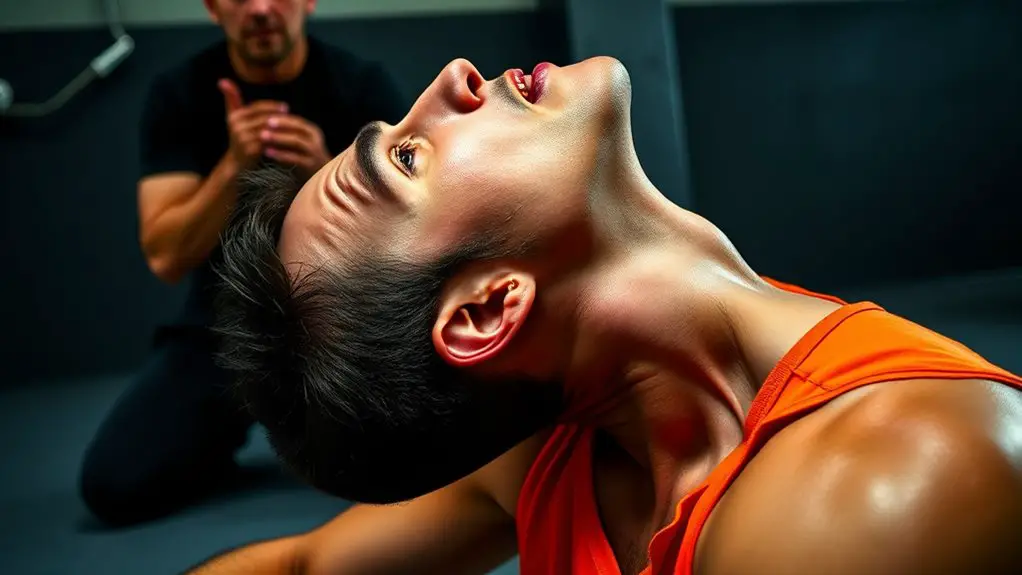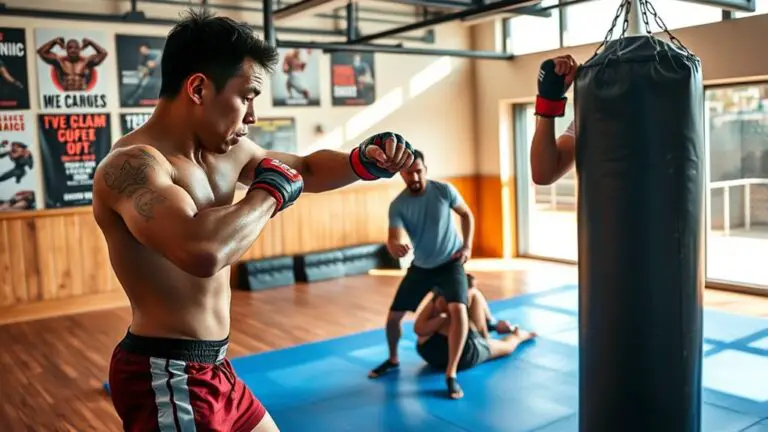How to Train Your Neck for Combat Sports

To train your neck for combat sports, focus on strengthening key muscles like the sternocleidomastoid and trapezius through exercises like neck flexion, extension, and rotation. Start with basic movements using bodyweight or resistance bands, performing 2-3 sets of 10-15 reps. As you progress, incorporate advanced techniques and weighted exercises. Always prioritize safety and allow for adequate recovery time. Monitoring your progress can help enhance performance. Discover further insights on effective training strategies as you continue.
Importance of Neck Strength in Combat Sports

While many athletes focus on overall body strength and conditioning, neglecting neck strength can be detrimental in combat sports. The neck plays an important role in maintaining balance, stability, and control during grappling and striking. Weak neck muscles can lead to an increased risk of injury, particularly in high-impact situations. Effective neck injury prevention strategies are vital for athletes to guarantee their longevity in the sport.
Incorporating targeted neck training into your regimen can enhance muscle resilience, which aids in rapid neck muscle recovery after strenuous activities. This not only reduces the likelihood of strains but also supports overall performance by allowing for quicker adjustments during combat. By prioritizing neck strength, you promote a robust kinetic chain, enabling better technique execution and minimizing the risk of debilitating injuries. Therefore, investing time in neck training is essential for any serious combat sport athlete.
Anatomy of the Neck: Understanding the Muscles
The neck is a complex structure comprised of several key muscles that play vital roles in movement and stability, particularly in combat sports. Understanding neck muscle types is essential for effective training. The primary muscles include the sternocleidomastoid, which aids in rotation and flexion, and the trapezius, responsible for extension and stabilization of the cervical spine. Deep neck flexors, such as the longus colli, help maintain posture and support the cervical spine anatomy.
You also have the scalene muscles, which assist in breathing and lateral flexion. Together, these muscles contribute to a robust neck structure, allowing for better head movement and impact absorption. Strengthening these muscles enhances performance and reduces injury risk during combat. By focusing on the unique functions of each muscle group, you’ll develop a thorough understanding necessary for effective neck training in sports contexts.
Basic Neck Exercises for Beginners

Building neck strength is essential for injury prevention and performance in combat sports. You can start with simple neck exercises that target the key muscle groups effectively. However, it’s important to follow safety tips to guarantee proper form and avoid strain during your training.
Importance of Neck Strength
Neck strength is essential in combat sports, as it not only enhances performance but also reduces the risk of injury. A strong neck stabilizes your head during impacts, minimizing the likelihood of whiplash or other neck injuries. Improved neck strength contributes to better posture and balance, vital for effective striking and grappling. To achieve ideal results, you’ll need to maintain a consistent training frequency, gradually increasing intensity as your strength improves. Incorporating targeted neck exercises into your routine can greatly enhance your resilience against the rigors of combat sports. Prioritizing neck strength not only safeguards your health but also elevates your overall athletic abilities, allowing you to compete at a higher level with confidence.
Simple Neck Exercises
While many athletes may overlook it, incorporating simple neck exercises into your training routine is essential for building foundational strength. These exercises enhance neck flexibility and stability, reducing the risk of injuries during combat sports.
Here’s a quick reference table for basic neck exercises:
| Exercise | Equipment |
|---|---|
| Neck Flexion | Bodyweight |
| Neck Extension | Bodyweight |
| Lateral Neck Flexion | Resistance Bands |
| Neck Rotation | Resistance Bands |
Start with 2-3 sets of 10-15 reps for each exercise. Gradually increase resistance or repetitions as your strength improves. Consistent practice will lead to noticeable gains in both strength and neck flexibility, vital for combat performance.
Safety Tips for Training
To guarantee a safe training experience, it’s crucial to prioritize proper form and technique during neck exercises. Start with basic movements, making sure your head and neck align correctly to avoid strain. Always warm up before engaging in any neck training; this promotes flexibility and reduces the risk of injury. Use appropriate training equipment, like resistance bands or neck harnesses, and verify they’re in good condition to maintain training equipment safety. Gradually increase resistance to allow your muscles to adapt, focusing on controlled movements. Pay attention to any discomfort; if you feel pain, stop immediately to aid in neck injury prevention. Consistent monitoring of your technique and equipment will enhance your training effectiveness while minimizing risks.
Advanced Neck Training Techniques

As you progress in combat sports, incorporating advanced neck training techniques can greatly enhance your performance and injury prevention. Focus on integrating advanced resistance training and dynamic neck stretches to build strength and flexibility.
| Technique | Description |
|---|---|
| Weighted Neck Flexion | Use a harness to add resistance while flexing your neck forward. |
| Isometric Neck Exercises | Press against a fixed object in all directions to enhance stability. |
| Resistance Band Rotations | Attach a band to a stable object and rotate your head against resistance. |
These exercises target different muscle groups in your neck, improving overall stability and resilience. Make certain you perform these techniques with proper form and gradually increase resistance to avoid injury. Consistent practice will not only fortify your neck but also contribute to better performance in combat scenarios.
Incorporating Neck Training Into Your Routine
Incorporating neck training into your routine is vital for maximizing performance and minimizing injury risk in combat sports. Start by integrating necktie exercises, which specifically target the neck muscles, enhancing strength and stability. These exercises can be performed using resistance bands, allowing for adjustable tension and progressive overload.
Aim to include neck training sessions two to three times a week, ensuring you allocate sufficient time for recovery. Begin with basic necktie exercises, gradually increasing resistance as you become more comfortable. Proper form is essential; maintain controlled movements to prevent strain.
You can also incorporate neck training into your warm-up or cool-down routines. For example, perform light resistance band exercises to activate the neck muscles before sparring. This approach not only prepares your neck for the demands of combat sports but also helps reinforce muscle memory. Consistency in your training regimen will yield significant benefits over time.
Safety Tips for Neck Training

Before you start neck training, it’s vital to implement proper warm-up techniques to prepare your muscles and joints. Avoiding excessive strain is essential, as overexertion can lead to injury. Always listen to your body; if you feel pain or discomfort, stop the exercise immediately.
Proper Warm-Up Techniques
A proper warm-up is essential for preparing your neck for the rigors of combat sports. Start with dynamic stretches to enhance flexibility and blood flow. Exercises like neck circles and lateral flexion help activate the cervical muscles. Follow these with mobility drills, such as gentle resistance movements against your hands, to promote joint stability. These drills guarantee your neck is primed for movement and can withstand the demands of training. Additionally, consider incorporating shoulder rolls to extend the warm-up to surrounding muscle groups, further supporting neck function. Always focus on controlled movements to minimize risk while maximizing effectiveness. This structured approach fosters a solid foundation for more intense neck training and injury prevention.
Avoiding Excessive Strain
While neck training is essential for combat sports, it’s important to avoid excessive strain that could lead to injury. Start with light resistance and gradually increase intensity as your strength improves. Make sure you’re using proper form throughout each exercise to minimize the risk of neck strain. Incorporate rest days into your routine to allow for muscle recovery, as overtraining can exacerbate the risk of injury. Always engage in a thorough warm-up and cool-down to prepare your neck muscles and promote flexibility. If you feel any discomfort or pain during training, stop immediately to prevent further injury. Focusing on these principles will enhance your training effectiveness while prioritizing injury prevention and long-term health.
Listening to Your Body
Listening to your body during neck training is essential for preventing injury and ensuring effective workouts. Developing body awareness helps you recognize pain signals and adjust your training accordingly. Here are some safety tips to keep in mind:
- Start with light resistance to gauge your limits.
- Pay attention to any discomfort or pain; stop immediately if it occurs.
- Incorporate rest days to allow your neck muscles to recover.
- Maintain proper form to avoid unnecessary strain.
- Gradually increase intensity to prevent overloading your neck.
Common Mistakes to Avoid

When training your neck for combat sports, it’s vital to recognize and avoid common mistakes that can hinder progress and lead to injury. One common pitfall is neglecting proper warm-up and cool-down routines. Skipping these steps can result in muscle strains and reduced flexibility.
Another mistake is overloading your neck too quickly. Gradually increasing resistance and intensity is critical; otherwise, you risk injury. Additionally, focusing solely on one type of neck exercise can lead to imbalances. Incorporate a variety of movements to guarantee thorough strength development.
Inadequate recovery time is also a significant oversight. Your neck muscles need time to heal and adapt, so don’t train them every day. Finally, always prioritize form over quantity. Poor technique can exacerbate injuries and undermine your training efforts. By avoiding these common pitfalls, you can enhance your neck training effectiveness and maintain long-term health.
Measuring Your Progress in Neck Strength
After addressing common mistakes in neck training, it’s important to establish a reliable method for measuring your progress in neck strength. Effective progress tracking involves consistent strength assessments to verify you’re on the right path. Here are key methods to evaluate your neck strength:
- Neck Circumference Measurement: Track changes in neck size over time.
- Isometric Holds: Measure the duration you can hold specific neck positions against resistance.
- Dynamic Resistance Exercises: Assess the weight you can lift or resist in neck-specific movements.
- Functional Performance Tests: Evaluate your neck’s contribution to overall athletic performance during combat drills.
- Pain and Discomfort Levels: Monitor any changes in pain or discomfort during or after training sessions.
Frequently Asked Questions
How Often Should I Train My Neck Each Week?
When considering neck training frequency, aim for two to three sessions per week. This allows your muscles to recover while maximizing strength benefits. Each session should include a variety of exercises targeting different muscle groups. Consistent neck training enhances stability and reduces injury risk, particularly in high-impact activities. By committing to this routine, you’ll notice improved neck strength, which can greatly impact your overall performance and resilience in physical activities.
Can Neck Training Prevent Injuries in Other Body Areas?
Did you know that nearly 50% of athletes report neck injuries during their careers? Neck training can greatly aid in injury prevention, particularly by enhancing spinal alignment. Strengthening your neck muscles provides better support for your head and spine, reducing the risk of injuries in other areas, like the shoulders and back. By prioritizing neck training, you’re not just protecting your neck; you’re safeguarding your overall athletic performance and longevity.
What Equipment Do I Need for Neck Training?
For effective neck training, you’ll need specific neck training equipment and essential tools. Start with a neck harness, which allows for weighted resistance. A resistance band can also be beneficial for dynamic movements. Additionally, a stability ball can aid in developing neck strength and stability through various exercises. Finally, consider using a foam roller for recovery and muscle maintenance. These tools will help you build a strong, resilient neck.
Are There Age Restrictions for Neck Training?
There aren’t strict age restrictions for neck training, but it’s crucial to follow training guidelines tailored for youth athletes. Generally, younger individuals should focus on proper technique and body awareness rather than heavy loads. Starting with basic exercises can help develop strength safely. As they mature, gradually increasing intensity is advisable, ensuring they’re physically ready and supervised by knowledgeable coaches to prevent injury and promote effective training outcomes.
Can Neck Exercises Improve My Overall Athletic Performance?
You’ve probably heard your coach say, “Get your head in the game!” Well, neck exercises can actually boost your overall athletic performance. By increasing neck strength, you enhance stability, which translates to better posture and balance during activities. This improvement contributes to athletic endurance as well, allowing you to maintain peak performance longer. So, don’t overlook your neck training; it’s an essential element in achieving your athletic goals.





